#caleb pontipee
Explore tagged Tumblr posts
Text
seven brides is so much funnier imagining the version from my bf5 fic I gotta finish that shit lmao
#sherman cortez starring in the university production of seven brides as adam pontipee w/viv along side as millie was a PEAK TIER TAKE#also vert was gideon pontipee 😂#and simon was either benjamin or caleb lmao i cant remember im high as shit
0 notes
Text

Jane Powell as Milly lays down the law for the six youngest Pontipee brothers (clockwise, from bottom left: Tommy Rall as Frank, Mark Platt as Daniel, Jacques D'Amboise as Ephraim, Matt Mattox as Caleb, and Russ Tamblyn as Gideon, perched atop Jeff Richards as Benjamin) in these promotional stills for Seven Brides for Seven Brothers (1954).
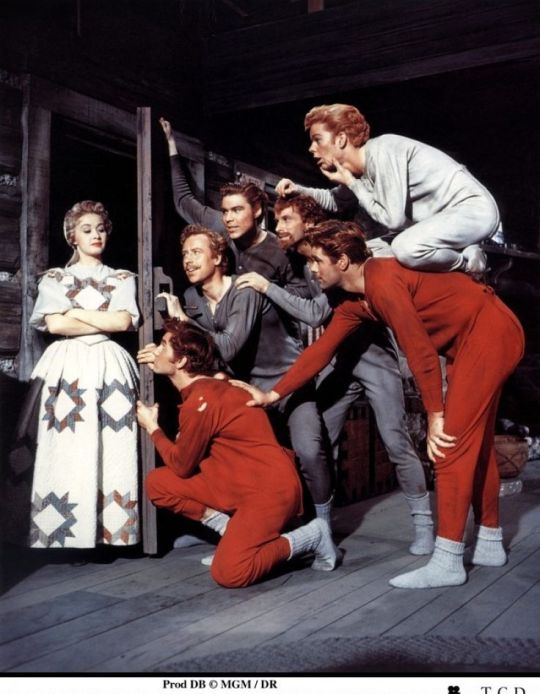
#historical hollywood#classic hollywood#seven brides for seven brothers#1954#1950s#promotional photos#movie musicals#wild wild westerns#period films#jane powell#tommy rall#mark platt#jacques d'amboise#matt mattox#russ tamblyn#jeff richards#strike a pose#glorious technicolor#winsome in white#radiant in red#glamorous in grey#scandalous in scanties
36 notes
·
View notes
Text

(warning: 90+ f/o’s)
❤️🩹books
found families ⊹₊ ⋆
The Weasley’s – Harry Potter saga ( books + films )
parents/guardians/caretakers ⊹₊ ⋆
/
siblings ⊹₊ ⋆
/
children ⊹₊ ⋆
/
other ⊹₊ ⋆
/
❤️🩹films/series/tv shows
found families ⊹₊ ⋆
The 6 heroes – Big Hero 6
The hotel family – Hotel Transylvania
The Madrigal’s – Encanto
Teen Titans – Teen Titans
The Teenagers + Star – Wish
The Watterson’s – The Amazing World of Gumball
parents/guardians/caretakers ⊹₊ ⋆
Athena + Triton – Disney’s The Little Mermaid trilogy ; parents
Brownlow + Fagin – Oliver Twist (2005) ; fatherly figures
CASE + TARS – Interstellar ; caretakers
Cass – Big Hero 6 ; caretaker / motherly figure
Clay Calloway – Sing 2 ; dad
Crobar – Pil ; caretaker
Dr. Delbert Doppler – Treasure Planet ; caretaker
Eli La Bouff – Disney’s The Princess and the Frog ; dad
James Wilson – House, M. D. ; dad
John Silver – Treasure Planet ; fatherly figure
King Frederic + Queen Anna – Disney’s Tangled ; parental figures
Kirsten Stevens – Set It Up ; adoptive mum
Klaus – Klaus ; dad
Klaus Kickenklober – Sing 2 ; caretaker
Linda + Rick Mitchell – The Mitchells vs the Machines ; parents
magic carpet – Aladdin ( films ) ; guardian
Merlin – The Sword in the Stone – mentor / caretaker
Phil – Disney’s Hercules ; guardian / mentor
Queen Amaya – Wish ; mum
Rafiki – The Lion King trilogy ; guardian
Sarah Hawkins – Treasure Planet ; caretaker / motherly figure
Sebastian – Disney’s The Little Mermaid trilogy ; caretaker
siblings ⊹₊ ⋆
Aaron + Katie Mitchell – The Mitchells vs the Machines ; siblings
Adella + Alana + Andrina + Aquata + Ariel + Arista + Attina – Disney’s The Little Mermaid trilogy ; sisters
Bobo + Cooky + Ralphy + Speedy + Sunny – 7 Zwerge trilogy ; brotherly figures
Charlotte La Bouff – Disney’s The Princess and the Frog ; twin sister
Johnny – Sing duology ; brotherly figure
Maleficent – Maleficent duology ; sisterly figure
Prince Average – Red Shoes and the 7 Dwarfs ; twin brother
children ⊹₊ ⋆
Márgu – Klaus ; daughter figure
Miguel Rivera – Coco ; son figure
Nimona – Nimona ; child figure
Pectine – Astérix: le Secrete de la Potion Magique ; child figure / protégé
Pil – Pil ; daughter figure / protégé
other ⊹₊ ⋆
Archibald + Daisy Suchot – Arthur and the Invisibles ; grandparents
Arthur Montgomery – Arthur and the Invisibles ; cousin
Gregory House – House, M. D. ; uncle figure
Melody – The Little Mermaid II: Return to the Sea ; niece
Preston B. Whitmore – Atlantis: the Lost Empire ; granddad
❤️🩹videogames
found families ⊹₊ ⋆
The Subway Surfers – Subway Surfers
parents/guardians/caretakers ⊹₊ ⋆
Aisha + Salim Alnazar – The Arcana ; parental figures
Constantine – Alchemy Stars ; guardian / caretaker / fatherly figure
Death – The Arcana ; guardian
Glamrock Freddy – Five Nights at Freddy’s: Security Breach ; guardian / caretaker
Soroz – Alchemy Stars ; guardian
siblings ⊹₊ ⋆
/
children ⊹₊ ⋆
Areia – Alchemy Stars ; protégé
Clover – Alchemy Stars ; daughter figure
Dove – Alchemy Stars ; child figure
Enlightener – Alchemy Stars ; daughter figure
Pasolo – Alchemy Stars ; daughter figure / protégé
Wendy – Alchemy Stars ; daughter figure
other
Shadow – Speedy Ninja ; brother-in-law
❤️🩹other type of source
found families ⊹₊ ⋆
Hundred Acre Wood inhabitants – Winnie the Pooh universe
Miss Bustier’s class – Miraculous universe
parents/guardians/caretakers ⊹₊ ⋆
Bill Woodward – Hatchetfield universe ; dad
Caline Bustier – Miraculous universe ; adoptive mum
Carmilla Carmine – Hellaverse ; motherly figure
Duke Keane – Hatchetfield universe ; adoptive dad
Mr. Chu – One Small Step ; adoptive dad
Panoramix – Astérix universe ; mentor
Sabine Cheng – Miraculous universe ; motherly figure
siblings ⊹₊ ⋆
Adam + Benjamin + Caleb + Daniel + Ephraim + Frank + Gideon Pontipee – Seven Brides for Seven Brothers ( musical ) ; brothers
Luna Chu – One Small Step ; foster sister
children ⊹₊ ⋆
Mike + Roger – OCs ; children figures
Octavia – Hellaverse ; daughter figure
other ⊹₊ ⋆
Tony Green – Hatchetfield universe ; father-in-law
2 notes
·
View notes
Photo


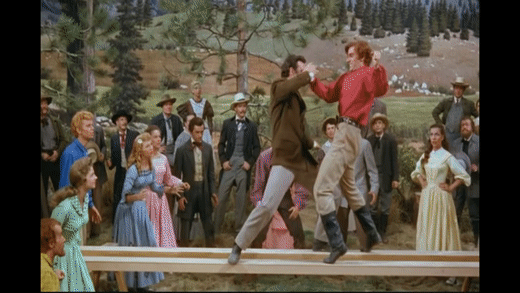




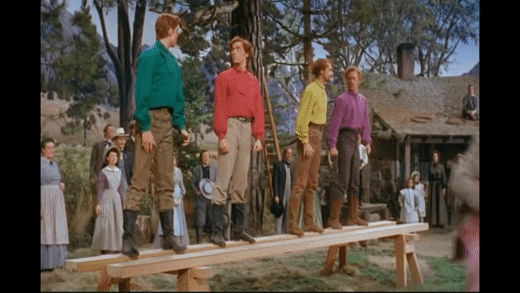

Pt 3 of gifs from the Barn Raising number in Seven Brides for Seven Brothers. Again, showcasing my particular fondness for Tommy Rall. I know others have made gifs from this movie. Great minds think alike.
#seven brides for seven brothers#tommy rall#russ tamblyn#marc platt#matt mattox#jacques d'amboise#frank pontipee#gideon pontipee#daniel pontipee#caleb pontipee#ephraim pontipee#dance#dancers#musicals#1950s musicals#1950s movies#gif#gifs#gifspam
85 notes
·
View notes
Text
hey friends! just wanted to introduce you all to my seven new brothers! the Pontipee brothers, from the musical Seven Brides for Seven Brothers !

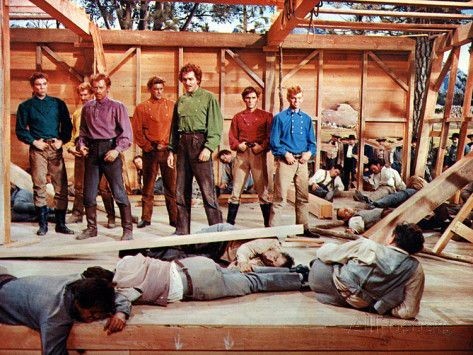
here they, and their respective wives are, oldest to youngest:
Adam & Milly !!

Benjamin & Dora !!

Caleb & Rita !!

Daniel & Lisa !!

Ephraim & Martha !!
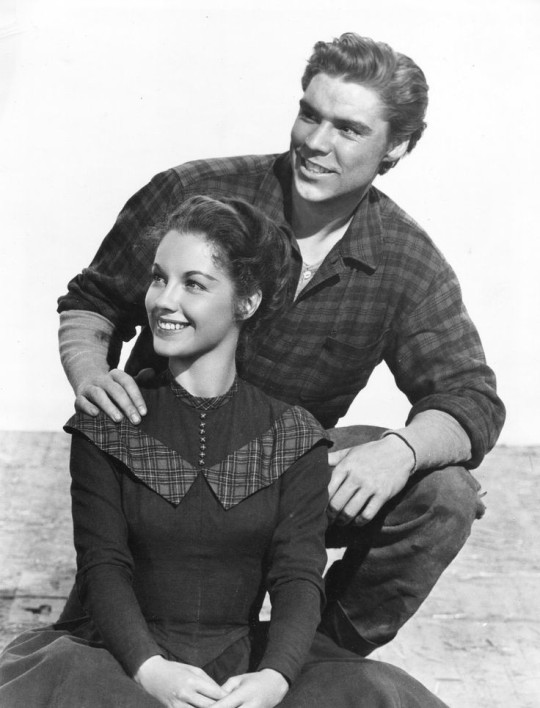
Frank (Frankincense) & Sarah !!

Gideon & Alice !!

i’ve also found this and i AHSHJRNDHDNJD THEM LMAO

27 notes
·
View notes
Photo
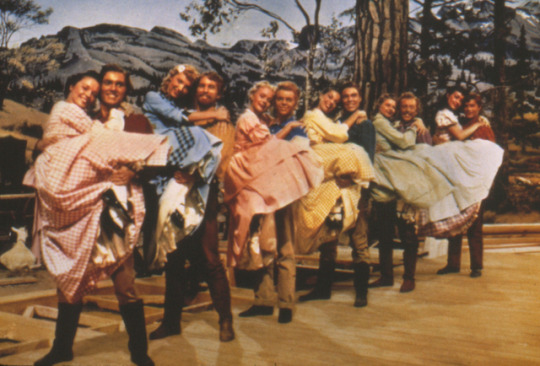
Seven Brides for Seven Brothers (1954)
In the early 1950s, Metro-Goldwyn-Mayer (MGM) had reached the peak of the studio’s powers, becoming the de facto home of the American movie musical. Its recent releases read like an honor roll: In the Good Old Summertime (1949), On the Town (1949), Annie Get Your Gun (1950), An American in Paris (1951), and Singin’ in the Rain (1952). For 1954, MGM needed to juggle two future additions to that list: Brigadoon and Seven Brides for Seven Brothers. The former starred Gene Kelly and Cyd Charisse, was directed by Vincente Minnelli (1944′s Meet Me in St. Louis, An American in Paris), and produced by the famed Arthur Freed unit. The Freed unit produced all of MGM’s A-list musicals, so the studio relegated Seven Brides for Seven Brothers as a “B” picture – cutting its production budget, slashing advertising expenditures. Stanley Donen’s (Singin’ in the Rain, 1955′s It’s Always Fair Weather) movie came dangerously close to being permanently shelved by MGM, but production did commence. In the end, Seven Brides for Seven Brothers outperformed Brigadoon in almost all metrics. And despite its very politically incorrect premise, it has held up better than Brigadoon as well as most musical films from that decade.
It is 1850 in Oregon Territory. Adam Pontipee (Howard Keel) has come down from the mountains – chest forward, masculinity erect for all the villagers to see – to announce he is here to find a bride. After eavesdropping on Milly (Jane Powell) and noting her sassiness and dedication to finishing her chores, he proposes, and she accepts without much question or resistance. Believing she is going home with Adam and only Adam, she is surprised that he also lives with six younger brothers – Benjamin (Jeff Richards), Caleb (Matt Mattox), Daniel (Marc Platt), Ephraim (Jacques d’Ambroise), Frank (Tommy Rall), and Gideon (Russ Tamblyn) – all of whom are ill-mannered slobs, are conveniently colored-coded by the costume design, and most of the six younger Pontipee brother actors are dancers (explained below). Furious at Adam, Milly demands an explanation. He responds that living in the backwoods requires men and women depending on each other to thrive. In time, Milly decides to teach the seven brothers proper etiquette and how to clean up after themselves.
I would be remiss without mentioning the six other women who become the brides (in alphabetical order with who they are hitched with, from Benjamin to Gideon): Dorcas (Julie Newmar), Ruth (Ruta Kilmonis), Martha (Norma Doggett), Liza (Virginia Gibson), Sarah (Betty Carr), and Alice (Nancy Kilgas).
Seven Brides for Seven Brothers is based on “The Sobbin’ Women” by Stephen Vincent Benét – a parody of the Roman mythological tale of the Rape of the Sabine Women. Wait! One quick explanation, please! Regarding the Rape of the Sabine Women, the word “rape” in the classical context refers to the Latin word “raptio”, which means abduction rather than the contemporary definition of rape. But this means the six other brides will be abducted by the Pontipee siblings – setting up the film’s frantic, comedic finale. A piece of modern feminism Seven Brides is not. Yet viewers need to consider that the seven men in the film have lived their lives in the Oregonian forests, with only Adam having infrequent contact with women and society at the most. The six younger Pontipee brothers might never have met women in a social context; their only understanding of women is through the Greek/Roman myths that Milly has read to them (considering the Rape of Sabine Women and Zeus/Jupiter’s behavior, you are right to be a bit horrified).
The Pontipees know nothing of physical boundaries, being respectful of women, and believe that they – perhaps not necessarily as men, but as individuals – should have what they want. Do you really expect them to not behave like lechers? Through the musical score, Seven Brides positions itself as a satire (and, especially in a scene where the younger Pontipees are trying not to knock other men’s lights out, often a hilarious one), never endorsing the behaviors of the Pontipee brothers. This tale of frontier courtship integrates Stockholm Syndrome (a psychological condition in which a hostage develops sympathetic feelings for their captor; also a narrative trope that has been abused by numerous artistic mediums). This is the point where the film’s screenplay by Albert Hackett (The Thin Man series), Frances Goodrich (Hackett’s spouse and co-writer), and Dorothy Kingsley (numerous Esther Williams movies including 1953′s Dangerous When Wet). As entertaining as Seven Brides is from its opening minutes, the women just seem too forgiving of the Pontipee brothers. Milly, in her active and open resistance to all that Adam is teaching his younger siblings, turns a one-sided argument into a battle of the sexes – making this a far more watchable film than it might otherwise have been.
For the musical team of supervisor Saul Chaplin (1961′s West Side Story), score composer Adolph Deutsch (1960′s The Apartment), song composer Gene de Paul, lyricist Johnny Mercer (maybe the best English-language lyricist from the 1930s-50s), and orchestrators Leo Arnaud (a longtime MGM contractee best known for “Bugler’s Dream”, a theme for American television’s presentation of the Olympics) and Alexander Courage (also a long-serving MGM contractee, but best known for his theme to Star Trek: The Original Series), Seven Brides for Seven Brothers’ musical score is spectacular from the very first song.
That first song? “Bless Your Beautiful Hide”, sung by Howard Keel in the opening minutes. The catchiest song in the film, it also serves as burning a hole through any expectations of clumsy or overlong exposition that can ruin a musical. In two-and-a-half minutes of Keel’s accented, blustering, unusually expressive bass-baritone, “Bless Your Beautiful Hide” has successfully introduced Adam Pontipee – that he is searching for a woman to sling over his shoulder, that she be at least conventionally pretty and not fat, can do work around the house, and someone who is “SASSY as can be!” One could not ask for a better introductory song than this. The song, “When You’re In Love” is a demonstration of Milly’s more refined nature against the rugged Adam. It is the song’s reprise – sung by Adam? – that poses problems. Keel also objected to the reprise’s placement in the film, saying that Adam did not understand what love is the moment he reprises the song (one could interpret it as Adam parroting Milly’s song, not fully understanding the lyrics, but I am not of that camp). Other highlights include Jane Powell singing “Goin’ Courtin’” a few scenes before Adam counters with “Sobbin’ Women” – recounting the story of the Rape of the Sabine Women, and setting the film’s resolution in motion. Seven Brides might not have the most memorable score, but it’s musically fascinating and I can’t label any of its de Paul and Mercer songs – okay, maybe “Wonderful, Wonderful Day” – as a dud.
But we haven’t gotten to the film’s ultimate musical accomplishment yet. Enter the barn dance sequence – an inspired composition by Adolph Deutsch and choreographer Michael Kidd (1953′s The Band Wagon, It’s Always Fair Weather). Alongside the excellent orchestration by Arnaud and Courage, the cue that accompanies this scene is just as fun to listen to within the film as well as when removed from it. Based heavily on “Bless Your Beautiful Hide”, the melody is passed back between strings and woodwinds with infectious zest. Infectious Western-styled themes; string-crossing; finger-numbing runs from the string section set the pace; and, when timed to the athletic, rather than balletic, choreography (the actors who played the six younger Pontipee brothers, the women, and the other suitors are all magnificent dancers), epitomizes the peak of the 1950s MGM musical. Because of the technical footwork, Donen sought to cast six dancers as the younger Pontipee brothers. Three weeks of rehearsal were needed just to record these several minutes of breathtaking movement.
youtube
Why resort to fisticuffs when things can be settled with a dance-off? Instrumentalists, dancers, and those who just love a good musical number will be left in awe here. For those who wanted to see a cartoonish brawl ensue, don’t feel deflated. This film will fulfill your wishes a few minutes after this, too!
Because of the film’s lack of support from MGM executives, the original plans to shoot on-location in Oregon fell through. The screenplay calls for the depiction of all four seasons, which would require a year-round shoot that MGM did not want to cough up for a “B” picture. Thus, Seven Brides for Seven Brothers would be shot almost entirely on the MGM backlot in a soundstage – which allows for some glaringly artificial painted backdrops and foliage that the viewer needs to overlook to enjoy such an electric musical. With production design as clunky as the Yellow Brick Road backdrops in The Wizard of Oz (1939), Seven Brides for Seven Brothers feels like it could have been made decades earlier. But don’t think Seven Brides is stuck in a previous decade. The��film was shot on CinemaScope (a widescreen screen aspect format, though not represented in the video provided for the barn raising sequence, that had been introduced the previous year) as well as the then-industry standard 4:3 format – not all theaters had the technology to present CinemaScope or other widescreen formats yet. As a result, Seven Brides for Seven Brothers was shot in and exists in two different formats: a CinemaScope and a 4:3 version. This review was based on the CinemaScope version shown on Turner Classic Movies (TCM), and it is also the print I recommend you watch.
This is a musical movie I had been holding off on for years, for insubstantial reasons. In the end, Seven Brides for Seven Brothers – because of its depiction of men asserting their own gendered primacy – may not appeal to all audiences, and I will not quarrel with anyone who has given Donen’s film a mindful look. The film is hampered by the nature of its narrative and external, business-side limitations. Those aspects should not define it. Seven Brides for Seven Brothers’ gorgeous musical score culminates in a stunning dance scene and contains an unexpectedly thoughtful look on how a single person can inspire change in another (not exclusively in terms of “fixing” them), making this a splendid addition to the best musical lineup produced by any Hollywood studio.
My rating: 8.5/10
^ Based on my personal imdb rating. Half-points are always rounded down. My interpretation of that ratings system can be found here.
#Seven Brides for Seven Brothers#Stanley Donen#Howard Keel#Jane Powell#Jeff Richards#Julie Newmar#Matt Mattox#Ruta Kilmonis#Marc Platt#Norma Doggett#Jacques d'Amboise#Virginia Gibson#Tommy Rall#Betty Carr#Russ Tamblyn#Nancy Kilgas#Gene de Paul#Johnny Mercer#TCM#My Movie Odyssey
6 notes
·
View notes
Text
Matt Mattox
Matt Mattox (1921 – 2013) grew up in Tulsa, Oklahoma. Born as Harold Henry Mattox in 1921, left an everlasting mark on jazz dance in both the Europe and the US. Mattox spent more than 30 of his later years in France developing his own technique of jazz. He formed jazz into a dance style all its own, creating much of the customs and vocabulary following jazz dance. His formal dance training didn’t begin until he was 11 years old and his family moved from Oklahoma to Los Angeles. Mattox had a ballet background which put gave him many jobs, including screen and stage. “In the Hollywood realm, Mattox held nearly 20 movie roles and made a lasting impression as frontiersman Caleb Pontipee in “Seven Brides for Seven Brothers” (1954)” (Semko). Mattox’s mentor was Jack Cole and was often believed to have set Mattox’s focus on jazz after casting him as a dancer in “Magdalena” on Broadway. Mattox decided that “From the mid-1950s on, Mattox taught his art to countless students…He began in New York and later went to London, where he created his own company, JazzArt, and taught for 5 years at the London’s Dance Centre” (Semko). Mattox found a passion for teaching; he did not know he had. He taught and created as much work as he could in the meantime. Not feeling fulfilled “He ultimately settled in the French commune of Roussillon in the 1980s with his wife, Martine Limeul Mattox, whom he met in London in the mid-1970s. Both dancers kept busy schedules teaching at Ecole Jazz Art Matt Mattox. He taught until he was nearly 90 years old. Mattox died in France in 2013, at the age of 91” (Semko). Matt Mattox was one of the most influential teachers, attempting to make sure his legacy lives on, which it surely does.
1 note
·
View note
Audio
If you haven't heard this song and you like theater, you NEED to. The Brothers are just amazing!!!
*Some mature lyrics if you can understand the way they talk in the 1850's
#Seven Brides for Seven Brothers#benjamin pontipee#caleb pontipee#daniel ponitppe#ephraim pontipee#frankincense pontipee#gideon pontipee#brothers are awesome
2 notes
·
View notes
Text
🌙 familial f/o’s 🌙
found families:
the 6 heroes – Big Hero 6 ( film )
Aisha + Salim Alnazar – the Arcana ( videogame )
Madrigal's – Encanto ( film )
Teen Titans – Teen Titans ( cartoon )
Top Gun – Top Gun: Maverick ( film )
Watterson's – Gumball ( cartoon )
Weasley's – Harry Potter ( books + films )
parents/guardians/caretakers:
Athena + Triton – Disney’s the Little Mermaid ( films ) ; parents
Augustus Landor – The Pale Blue Eye ( film ) ; fatherly figure
Bill Woodward – Hatchetfield universe ; dad
CASE + TARS – Interstellar ( film ) ; caretakers
Cass – Big Hero 6 ( film ) ; caretaker / motherly figure
Clay Calloway – Sing ( films ) ; dad
Constantine – Alchemy Stars ( videogame ) ; guardian / caretaker / fatherly figure
Death – the Arcana ( videogame ) ; guardian
Dr. Doppler – Treasure Planet ( film ) ; caretaker
Duke Keane – Hatchetfield universe ; adoptive dad
Glamrock Freddy – Five Nights at Freddy’s: Security Breach ( videogame ) ; guardian / caretaker
James Wilson – House, M. D. ( TV series ) ; dad
John Silver – Treasure Planet ( film ) ; fatherly figure
Kalique Abrasax – Jupiter: Ascending ( film ) ; caretaker
Klaus Kickenklober – Sing ( films ) ; caretaker
magic carpet – Aladdin ( films ) ; guardian
Peter B. Parker – Spiderman: Into the Spider-Verse ( film ) ; fatherly figure
Phil – Disney’s Hercules ( film and cartoon ) ; guardian
Rafiki – the Lion King ( films ) ; guardian
Sarah Hawkins – Treasure Planet ( film ) ; caretaker / motherly figure
Sebastian – Disney's the Little Mermaid ( films ) ; caretaker
Soroz – Alchemy Stars ( videogame ) ; guardian
Tony Green – Hatchetfield universe ; fatherly figure
siblings:
Adam + Benjamin + Caleb + Daniel + Ephraim + Frank + Gideon Pontipee – Seven Brides for Seven Brothers ( musical ) ; brothers
Adella + Alana + Andrina + Aquata + Ariel + Arista + Attina – Disney’s the Little Mermaid ( films ) ; sisters
Bobo + Cooky + Ralphy + Speedy + Sunny – 7 Zwerge ( films ) ; brotherly figures
Johnny – Sing ( films ) ; brotherly figure
Maleficent – Maleficent saga ( films ) ; sisterly figure
Prince Average – Red Shoes and the 7 Dwarfs ( film ) ; twin brother
Shadow – Speedy Ninja ( videogame ) ; brotherly figure
children:
Dove – Alchemy Stars ( videogame ) ; child figure
Miguel Rivera – Coco ( film ) ; son figure
Mike – OC ; child figure
Pectine – Astérix: Le Secrete de la Potion Magique ( film + comic )
Roger – OC ; son figure
Wendy – Alchemy Stars ( videogame ) ; daughter figure
others:
Archibald + Daisy Suchot – Arthur and the Invisibles ( films ) ; grandparents
Arthur Montgomery – Arthur and the Invisibles ( films ) ; cousin
Gregory House – House, M. D. ( TV series ) ; uncle figure
Melody – the Little Mermaid II: Return to the Sea ( film ) ; niece
Preston B. Whitmore – Atlantis: the Lost Empire ( films ) ; granddad
5 notes
·
View notes
Note
*t-poses to assert dominance*
Tell us about your 7 sibs
GLADLY
so!! first of all, their mom and dad wanted to give them biblical names in alphabetical order (in fact, Adam is the eldest, then Benji, Caleb and so on). the only one who hasn’t got a biblical name is Frank (Frankincense is his full name), because mr. Pontipee couldn’t find any name starting with an F, but his wife thought the baby had a good smell, so that’s why they called Frank that ^^
they’re all amazing dancers, a lot acrobatic, and love fighting, especially all together. they always win because 1. they are lumberjacks, so pretty strong, and 2. well.. they’re seven lumberjacks lol
uhmm, Adam did his best to raise his brothers, considering it was the 30s/40s, but, you know, men at that time,, yeah. he was looking for the perfect wife - well he actually had more of a housewife in mind lmao - and fortunately found Milly! bless that girl. she’s been patient and stubborn enough (and especially madly in love with Adam) to teach some manners to all of them. and they learnt very well!
.. until Adam told them to kidnap the girls they liked. no bad intentions intended, klar! they were all six a lot in love, and wanted their girls at all costs, and they were also used to listen to Adam, so.. they took the girls - who luckily were in love with them too. and, although they clearly didn’t appreciate the gesture, they could’t help but be disappointed into returning home to their dads.
i won’t tell everything just in case someone wants to watch the show, but i really like & recommend it!!
also, so far, heres some info about my s/i!
her real name’s Hannah
mom couldn’t make it after giving her birth .. :(
she has only two years gap with Gideon
as she grew, dad - and brothers too - noticed the meaning of her name (grace, graceful) didn’t really fit her so everyone calls her Haley (heavy rainfall)
when dad passed away, Adam didnt exclude her from working as a lumberjack to get money, so she is pretty strong too
she can behave as a lady, as her dad taught her till she was 7, if she wants, but definitely prefers fighting with her brothers and wearing trousers like them
though shes the only one to not make a mess while eating lol
5 notes
·
View notes